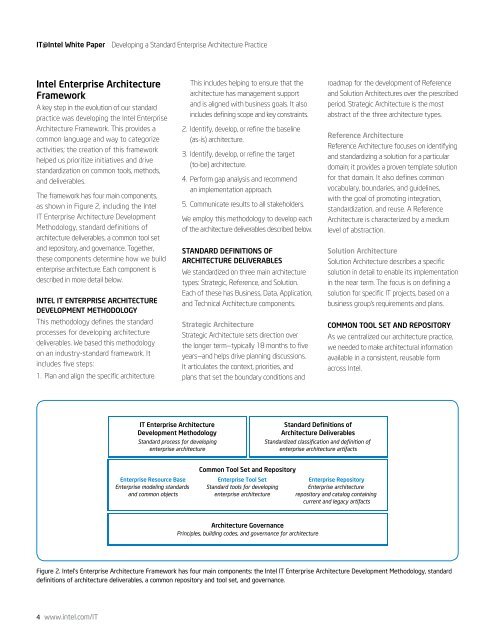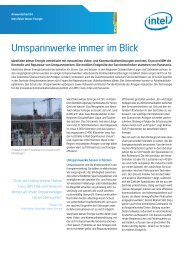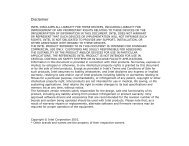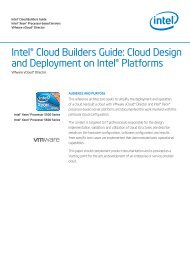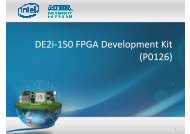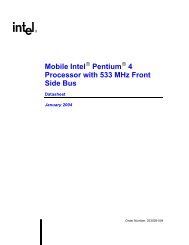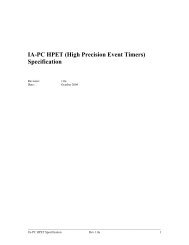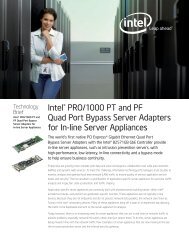IT@<strong>Intel</strong> <strong>White</strong> Paper<strong>Developing</strong> a <strong>Standard</strong> <strong>Enterprise</strong> <strong>Architecture</strong> <strong>Practice</strong><strong>Intel</strong> <strong>Enterprise</strong> <strong>Architecture</strong>FrameworkA key step in the evolution of our standardpractice was developing the <strong>Intel</strong> <strong>Enterprise</strong><strong>Architecture</strong> Framework. This provides acommon language and way to categorizeactivities; the creation of this frameworkhelped us prioritize initiatives and drivestandardization on common tools, methods,and deliverables.The framework has four main components,as shown in Figure 2, including the <strong>Intel</strong>IT <strong>Enterprise</strong> <strong>Architecture</strong> DevelopmentMethodology, standard definitions ofarchitecture deliverables, a common tool setand repository, and governance. Together,these components determine how we buildenterprise architecture. Each component isdescribed in more detail below.INTEL IT ENTERPRISE ARCHITECTUREDEVELOPMENT METHODOLOGYThis methodology defines the standardprocesses for developing architecturedeliverables. We based this methodologyon an industry-standard framework. Itincludes five steps:1. Plan and align the specific architecture.This includes helping to ensure that thearchitecture has management supportand is aligned with business goals. It alsoincludes defining scope and key constraints.2. Identify, develop, or refine the baseline(as-is) architecture.3. Identify, develop, or refine the target(to-be) architecture.4. Perform gap analysis and recommendan implementation approach.5. Communicate results to all stakeholders.We employ this methodology to develop eachof the architecture deliverables described below.STANDARD DEFINITIONS OFARCHITECTURE DELIVERABLESWe standardized on three main architecturetypes: Strategic, Reference, and Solution.Each of these has Business, Data, Application,and Technical <strong>Architecture</strong> components.Strategic <strong>Architecture</strong>Strategic <strong>Architecture</strong> sets direction overthe longer term—typically 18 months to fiveyears—and helps drive planning discussions.It articulates the context, priorities, andplans that set the boundary conditions androadmap for the development of Referenceand Solution <strong>Architecture</strong>s over the prescribedperiod. Strategic <strong>Architecture</strong> is the mostabstract of the three architecture types.Reference <strong>Architecture</strong>Reference <strong>Architecture</strong> focuses on identifyingand standardizing a solution for a particulardomain; it provides a proven template solutionfor that domain. It also defines commonvocabulary, boundaries, and guidelines,with the goal of promoting integration,standardization, and reuse. A Reference<strong>Architecture</strong> is characterized by a mediumlevel of abstraction.Solution <strong>Architecture</strong>Solution <strong>Architecture</strong> describes a specificsolution in detail to enable its implementationin the near term. The focus is on defining asolution for specific IT projects, based on abusiness group’s requirements and plans.COMMON TOOL SET AND REPOSITORYAs we centralized our architecture practice,we needed to make architectural informationavailable in a consistent, reusable formacross <strong>Intel</strong>.IT <strong>Enterprise</strong> <strong>Architecture</strong>Development Methodology<strong>Standard</strong> process for developingenterprise architecture<strong>Standard</strong> Definitions of<strong>Architecture</strong> Deliverables<strong>Standard</strong>ized classification and definition ofenterprise architecture artifacts<strong>Enterprise</strong> Resource Base<strong>Enterprise</strong> modeling standardsand common objectsCommon Tool Set and Repository<strong>Enterprise</strong> Tool Set<strong>Standard</strong> tools for developingenterprise architecture<strong>Enterprise</strong> Repository<strong>Enterprise</strong> architecturerepository and catalog containingcurrent and legacy artifacts<strong>Architecture</strong> GovernancePrinciples, building codes, and governance for architectureFigure 2. <strong>Intel</strong>’s <strong>Enterprise</strong> <strong>Architecture</strong> Framework has four main components: the <strong>Intel</strong> IT <strong>Enterprise</strong> <strong>Architecture</strong> Development Methodology, standarddefinitions of architecture deliverables, a common repository and tool set, and governance.4 www.intel.com/IT
<strong>Developing</strong> a <strong>Standard</strong> <strong>Enterprise</strong> <strong>Architecture</strong> <strong>Practice</strong>IT@<strong>Intel</strong> <strong>White</strong> PaperAccordingly, in 2006 we standardized ona single enterprise architecture tool set.Previously, disparate groups of enterprisearchitects used different tools to createand maintain architectural information. Inconjunction with this, we created a commonrepository and a single portal for accessingour standard processes, templates, and tools.<strong>Standard</strong>ization made it easier to reuse andshare architectural artifacts such as diagramsand reports across <strong>Intel</strong>. This helped promotereuse and improve the quality and consistencyof deliverables.GOVERNANCEStrong governance is essential to develop aconsistent enterprise-wide practice and tohelp ensure that IT projects comply with theestablished architecture standards.Our initial steps included defining a set ofenterprise architecture principles that weuse to guide our architecture policies andstandards. These principles include enablingbusiness strategy, designing solutions withthe end user’s needs in mind, and addressingproduction support requirements.IT Building CodesWe created IT Building Codes designed to alignprojects to the relevant architecture. Theycontain policies, standards, and proceduresfor project areas such as security, usability,and hosting.Each project must assess which codes arerelevant and then use a scorecard to measurecompliance. Compliance involves adherence tospecific Blue Books, the use of the appropriatetools, providing required documentation, andother requirements. This self-assessmentmodel simplifies project management byallowing project managers to make moredecisions themselves, consulting with anenterprise architect only as necessary.Streamlining Decision MakingIn 2007, <strong>Intel</strong> IT adopted a standarddecision making methodology for useacross the IT organization, including theenterprise architecture group. By applyingthis methodology, we identified the needfor a top enterprise architecture technicaldecision making body. We call this body the<strong>Enterprise</strong> <strong>Architecture</strong> Council (EAC).The EAC approves, promotes, and enforcesarchitecture technical standards. It includes<strong>Intel</strong> IT senior management and is chaired bythe head of the <strong>Intel</strong> IT enterprise architecturegroup. The council creates committees thatrecommend ratification of changes to BuildingCodes; audit compliance to architecture; andapprove waivers. There are also workgroupsand committees focused on specificarchitecture topics.Talent DevelopmentTo translate business needs into technologyarchitecture, enterprise architects at <strong>Intel</strong> areexpected to speak the language of businessand acquire Business <strong>Architecture</strong> skills.We established a series of programs andforums to facilitate the development ofa broad, common skill set and to createa culture that unifies architects withdifferent backgrounds. For example, weprovided opportunities for enterprisearchitects to participate in an industrystandardcertification program, with thegoal of growing a worldwide, standardenterprise architecture competency. We alsoestablished an internal mentoring program.Our aim was to help architects becomeconversant with all four architecturaldisciplines—Business, Data, Application, andTechnology—and strengthen proficiency in bothstrategic and tactical architecture development.Ongoing forums provide opportunities forarchitects to learn and share information.Practitioners meet regularly to share bestknownmethods, network, and integrate <strong>Intel</strong>’senterprise architecture. These forums arereinforced by an annual internal conference,the <strong>Enterprise</strong> <strong>Architecture</strong> Summit.We also developed a handbook to helparchitects learn or refresh their memoriesabout specific enterprise architecture topicsand a newsletter to share interesting projectsand successes.Assessment andContinuous ImprovementBased on the results of a broad <strong>Intel</strong> IT internalreview in 2007, IT management requires thatthat we provide an assessment of continuingefforts to improve our enterprise architecturepractice.To do this, we use an approach called <strong>Enterprise</strong><strong>Architecture</strong> Management (EAM), which is anelement of the IT Capability ManagementFramework (IT-CMF). <strong>Intel</strong> IT initially developedthe IT-CMF, and it is now part of the researchand education agenda of the Innovation ValueInstitute, a consortium of more than 50 industryand academic organizations (www.ivi.ie).EAM defines eight capability building blocksin three broad categories: planning, practices,and people. Within each of these areas,we assess the maturity of our practice,assigning a score from 1 to 5. Maturity isbased primarily on two factors: reach withinthe organization—from individual projects toenterprise-wide—and process sophistication.To manage the assessment, we establisheda core team that includes participants fromkey groups. The assessment results inspecific recommendations for improvementin each area. We continue to conductthese assessments annually; they havebecome the foundation of a continuousimprovement process. By implementingthe recommendations identified in eachassessment, we have achieved significantimprovements, as shown in Figure 3.www.intel.com/IT 5


